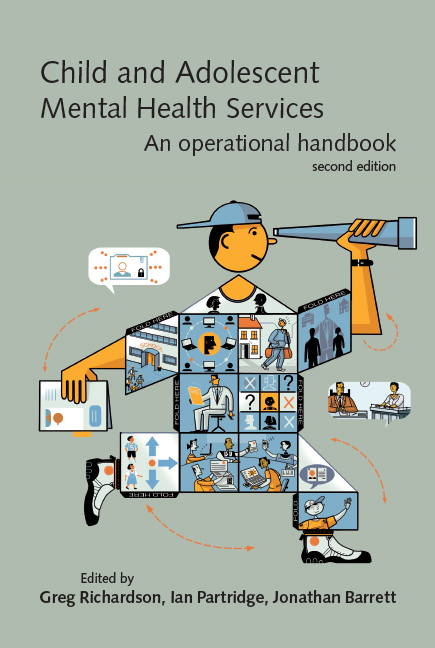Book contents
- Frontmatter
- Contents
- Tables, boxes and figures
- Contributors
- Abbreviations
- Preface
- 1 Introduction
- 2 CAMHS in context
- 3 CAMHS and the law
- 4 Structure, organisation and management of CAMHS
- 5 Evidence-based practice
- 6 Clinical governance
- 7 Education, supervision and workforce development
- 8 Multidisciplinary working
- 9 User and carer participation and advocacy
- 10 A comprehensive CAMHS
- 11 Referral management
- 12 Demand and capacity management
- 13 Strategies for working with Tier 1
- 14 Structuring and managing treatment options
- 15 CAMHS in the emergency department
- 16 Paediatric liaison
- 17 Self-harm
- 18 Learning disability services
- 19 Services for autism-spectrum disorders
- 20 Attentional problems services
- 21 Eating disorder teams
- 22 Bereavement services
- 23 CAMHS for refugees and recent immigrants
- 24 CAMHS and looked-after children
- 25 Drug and alcohol teams
- 26 Parenting risk assessment service
- 27 Court work
- 28 Tier 4 options
- 29 In-patient psychiatric care
- 30 Forensic services
- 31 Neuropsychiatry and neuropsychology services
- 32 Mental health provision for deaf children: study of a low-incidence service provision
- 33 Chief Executives – what do they want and how do they get it?
- Index
23 - CAMHS for refugees and recent immigrants
- Frontmatter
- Contents
- Tables, boxes and figures
- Contributors
- Abbreviations
- Preface
- 1 Introduction
- 2 CAMHS in context
- 3 CAMHS and the law
- 4 Structure, organisation and management of CAMHS
- 5 Evidence-based practice
- 6 Clinical governance
- 7 Education, supervision and workforce development
- 8 Multidisciplinary working
- 9 User and carer participation and advocacy
- 10 A comprehensive CAMHS
- 11 Referral management
- 12 Demand and capacity management
- 13 Strategies for working with Tier 1
- 14 Structuring and managing treatment options
- 15 CAMHS in the emergency department
- 16 Paediatric liaison
- 17 Self-harm
- 18 Learning disability services
- 19 Services for autism-spectrum disorders
- 20 Attentional problems services
- 21 Eating disorder teams
- 22 Bereavement services
- 23 CAMHS for refugees and recent immigrants
- 24 CAMHS and looked-after children
- 25 Drug and alcohol teams
- 26 Parenting risk assessment service
- 27 Court work
- 28 Tier 4 options
- 29 In-patient psychiatric care
- 30 Forensic services
- 31 Neuropsychiatry and neuropsychology services
- 32 Mental health provision for deaf children: study of a low-incidence service provision
- 33 Chief Executives – what do they want and how do they get it?
- Index
Summary
‘A cold coming we had of it.’
T. S. Eliot, Journey of the MagiIntroduction
The UK has a centuries-old tradition of receiving immigrants (Kushner & Knox, 1999; Winder, 2004). After the 1950s, the number of people coming to the UK predominantly from the Commonwealth countries of the Caribbean and South Asia (India, Pakistan and Bangladesh) increased. Recent migrants have come from all over the world with significant numbers from the European Union, South Asia and Ireland. The ethnicity of the UK is becoming more diverse with 8% belonging to Black and minority ethnic groups, mainly Asian or Asian British and Black or Black British, Mixed, or Chinese (Office of National Statistics, 2007). In 1981, just over 6% of the UK population had been born overseas, but this had risen to just over 8% by 2001 and almost 10% by 2006 (Office of National Statistics, 2007). The age structure of the population shows that ethnic minority groups have much higher proportions of young people (i.e. under 20 years) than White ethnic groups. Those born outside the UK have much higher fertility rates than those born in the UK, suggesting that the population may continue to become more ethnically heterogeneous.
Reasons for migration are varied. Immigrants may leave their countries of origin seeking improved life chances through work and educational opportunities. Since the Second World War, the UK has had high demand for immigrants to satisfy the demand of the labour market (Winder, 2004). Others have come as asylum seekers or refugees, fleeing their countries because of fear or experience of persecution and organised violence (Winder, 2004). Asylum seekers travel to resettlement countries, including the UK, and apply for rights to remain, which confers refugee status (UNHCR, 2006). Refugee status gives entitlement to work and benefits of the welfare state. Over the 15 years until 1998, it was estimated that approximately 300 000 refugees and asylum seekers came to the UK (Bardsley & Storkey, 2000). In 2006, there were 23 610 asylum applications to the UK, of which 6225 resulted in grants of asylum, humanitarian protection or discretionary leave (Home Office, 2007). The top five applicant nationalities in 2006 were: Eritrean, Afghan, Iranian, Chinese and Somali. One special group are unaccompanied asylum-seeking children who are under the age of 18 years on arrival (Watters, 2007).
- Type
- Chapter
- Information
- Child and Adolescent Mental Health ServicesAn Operational Handbook, pp. 214 - 225Publisher: Royal College of PsychiatristsFirst published in: 2017



